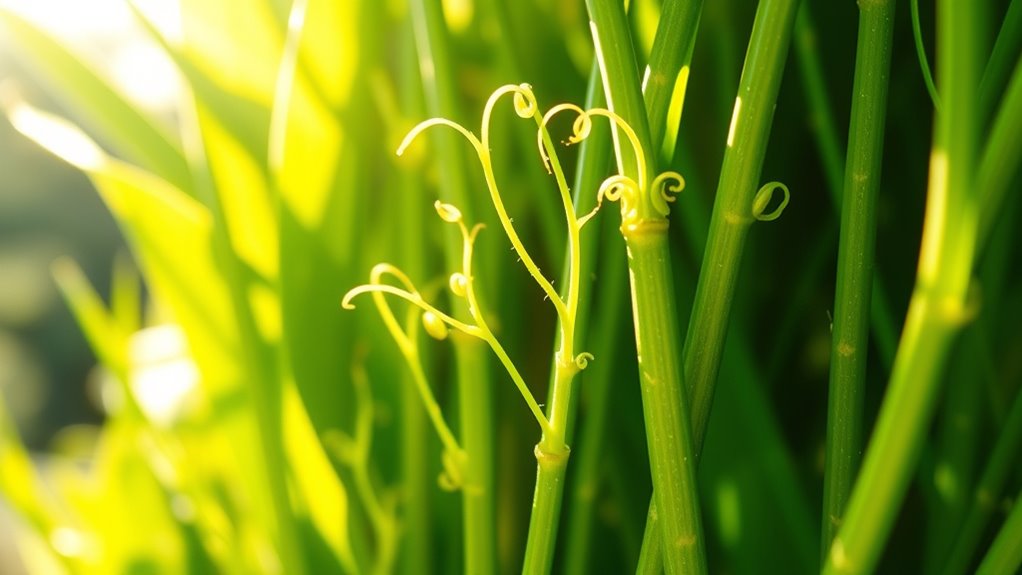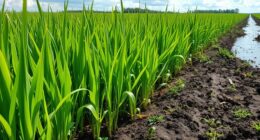In summer, auxins and gibberellins team up to boost plant growth, flowering, and root development. Auxins, produced at the tips, signal flowers and roots to grow strongly and stretch toward sunlight. Gibberellins promote rapid stem and leaf growth, making plants taller and more lush. Together, these hormones respond to warmth and sunlight, creating vibrant, thriving gardens. If you keep exploring, you’ll discover even more about how these hormones shape your plants during peak growth season.
Key Takeaways
- Auxins promote flowering, root growth, and cell elongation, especially stimulated by increased sunlight and warmth during summer.
- Gibberellins drive rapid stem elongation and larger leaves, leading to lush, vigorous plant growth in warm weather.
- Both hormones work synergistically: auxins initiate flowering and root development, while gibberellins amplify overall growth.
- Elevated temperatures and longer daylight hours boost the production and activity of auxins and gibberellins.
- Their combined effects ensure plants reach optimal size, flowering, and reproduction during summer growth spurts.

As summer arrives, many people turn their attention to naturally boosting growth hormones to enhance their health and fitness goals. While most focus on human hormones, plants also rely on natural regulators like auxins and gibberellins to promote vigorous growth during the warmer months. Understanding how these hormones work can help you better appreciate the subtle yet powerful processes behind plant growth spurts in summer.
Auxins are primarily responsible for flowering triggers and directing growth patterns. During summer, increased sunlight and warmth stimulate the production and distribution of auxins within plants. These hormones accumulate at specific sites, signaling the plant to develop flowers and fruits. By promoting cell elongation, auxins help plants stretch toward the sun, encouraging taller, more robust growth. They also influence root development, ensuring the plant establishes a strong foundation. The root tips produce auxins that travel downward, stimulating root elongation and branching, which in turn improves water and nutrient uptake. As you observe your garden thriving in summer, you’re witnessing auxins at work, maximizing flowering times and strengthening root systems to support rapid growth.
Auxins promote flowering, root growth, and cell elongation, supporting plant development during summer.
Gibberellins, on the other hand, are key players in growth spurts that happen during warm weather. They work by stimulating cell division and elongation, especially in the stems and leaves. When summer arrives, the increase in temperature and daylight triggers higher gibberellin production. This hormonal surge leads to noticeable growth, such as taller plants and larger leaves, giving your garden a lush, full appearance. Gibberellins also interact with auxins to coordinate flowering and seed development, ensuring plants reproduce effectively during the season of abundance. Their role in promoting cell elongation is essential for plants to reach ideal size quickly, making summer a prime time for vigorous growth.
Together, auxins and gibberellins create a dynamic hormonal environment that maximizes plant growth during warm months. Auxins set the stage by triggering flowering and supporting root development, establishing a strong base for the plant’s growth. Gibberellins then amplify this process by inducing rapid elongation and overall plant size increase. Additionally, understanding the plant hormone interactions provides insight into how environmental factors influence growth responses. As someone tending to plants or observing nature, you see these hormones working seamlessly to produce the lush, thriving greenery typical of summer. Recognizing their roles helps you understand why plants respond so dramatically to summer conditions, channeling warmth and sunlight into accelerated growth. Whether you’re nurturing a garden or simply enjoying nature’s summer display, it’s fascinating to realize how auxins and gibberellins orchestrate this seasonal growth spurt, ensuring plants flourish during the warmest months.
Frequently Asked Questions
How Do Auxins and Gibberellins Interact During Summer Growth?
During summer growth, auxins and gibberellins work together in a plant hormone synergy that promotes rapid development. You’ll notice seasonal hormonal shifts where auxins stimulate cell elongation, while gibberellins enhance cell division and overall growth. These hormones interact to optimize your plant’s warm-season growth spurts, ensuring they develop vigorously. By coordinating their effects, the plant efficiently adapts to summer conditions, maximizing growth potential during this active period.
Are There Environmental Factors Influencing Hormone Effectiveness?
You might think hormones work the same regardless of conditions, but environmental factors like moisture impact and soil temperature really matter. These conditions influence hormone effectiveness by affecting plant metabolism and hormone transport. When soil warms up and moisture levels are ideal, auxins and gibberellins work more efficiently, triggering growth spurts. So, yes, environmental factors directly shape how well these hormones promote summer growth.
Can Hormone Levels Be Artificially Manipulated for Better Growth?
You can artificially manipulate hormone levels through techniques like genetic modification and hormone delivery to enhance plant growth. By adjusting auxins and gibberellins, you may promote stronger, faster growth, especially during warm seasons. However, it’s crucial to take into account potential ecological impacts and regulatory guidelines. With proper application, you can optimize plant development, but always ensure your methods are safe, sustainable, and compliant with agricultural standards.
What Are the Long-Term Effects of Summer Hormone Treatments?
Think of hormone treatments like a double-edged sword—you might boost growth, but there are long-term risks. These treatments can sometimes reduce disease resistance, making plants more vulnerable, and may alter seed dispersal patterns, affecting reproduction. Over time, excessive hormone use could lead to unpredictable growth habits or weakened plants. You should weigh these potential effects carefully before relying on artificial hormone manipulation for sustained plant health and productivity.
How Do Hormones Affect Different Plant Species During Summer?
During summer, hormones like auxins and gibberellins influence plant species differently. You’ll notice changes in flower pigmentation, as hormones can enhance or alter color expression, and improve root development, helping plants access water and nutrients more efficiently. These effects vary depending on the species’ unique hormone sensitivities, so some plants respond quickly with vibrant blooms and strong roots, while others show more subtle changes.
Conclusion
As summer’s warmth wraps around your plants like a gentle, golden blanket, auxins and gibberellins act as nature’s secret catalysts, igniting vibrant growth. Think of them as tiny builders, tirelessly constructing lush leaves and sturdy stems beneath the sun’s watchful eye. With each passing day, they orchestrate a symphony of life, turning quiet buds into bursting bursts of green. Embrace these powerful hormones, and watch your garden wake up and bloom with unstoppable energy.










